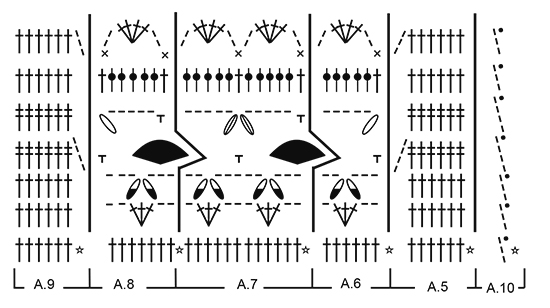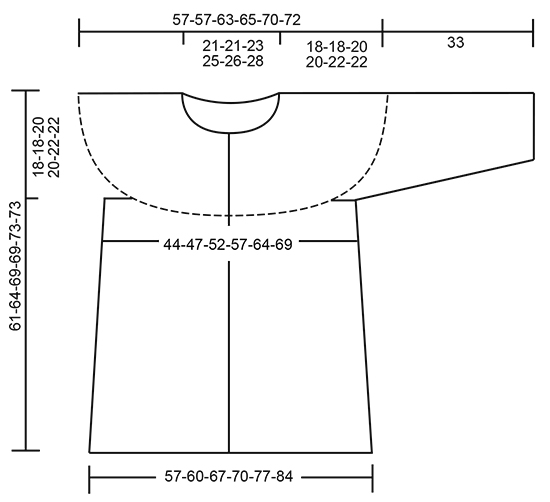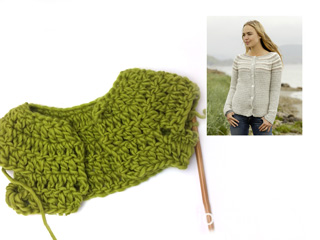Sahara Cardigan |
|||||||||||||||||||||||||||||||||||||
|
|
|||||||||||||||||||||||||||||||||||||
Crochet jacket with lace pattern, worked top down in DROPS Cotton Merino. Sizes S - XXXL.
DROPS 176-17 |
|||||||||||||||||||||||||||||||||||||
|
CROCHET INFO: For when the piece is worked back and forth. On every row with treble crochets, the first treble crochet is replaced by 3 chain stitches. On every row with double treble crochets, the first double treble crochet is replaced by 4 chain stitches. On every row with double crochets, the first double crochet is replaced by 1 chain stitch. INCREASE TIP: Increase 1 treble crochet by working 2 treble crochets in 1 treble crochet/double crochet. Do not increase on the band. DECREASE TIP: Work 1 treble crochet, but wait with the last yarn over and pull through, then work the next treble crochet and pull the last yarn over through all 3 loops on the hook – you have now decreased 1 treble crochet. PATTERN: See diagrams A.1 to A.10. A.10 shows how the pattern starts and finishes when working in the round on the sleeve. ---------------------------------------------------------- YOKE: The piece is worked top down back and forth. Work 171-171-181-186-191-201 chain stitches with hook size 4 mm and Cotton Merino. Work the next row as follows: 1 treble crochet in the 4th chain stitch (= 2 treble crochets), 1 treble crochet in each of the next 2 chain stitches, * skip 1 chain stitch, 1 treble crochet in each of the next 4 chain stitches *, repeat from *-* = 136-136-144-148-152-160 treble crochets. READ CROCHET INFO! Insert 12 markers in the piece as follows: Work 21-21-23-24-25-27 treble crochets AT THE SAME TIME increase 1-5-3-3-4-2 treble crochet/s evenly within these stitches – READ INCREASE TIP, insert the first marker, * work 4 treble crochets, insert the next marker *, repeat from *-* 1 more time, work 16 treble crochets, insert the next marker, * work 4 treble crochets, insert the next marker *, repeat from *-* 1 more time, work 30-30-34-36-38-42 treble crochets AT THE SAME TIME increase 2-10-6-6-8-4 treble crochets within these stitches, insert the next marker, * work 4 treble crochets, insert the next marker *, repeat from *-* 1 more time, work 16 treble crochets, insert the next marker, * work 4 treble crochets, insert the next marker *, repeat from *-* 1 more time, work 21-21-23-24-25-27 treble crochets AT THE SAME TIME increase 1-5-3-3-4-2 treble crochet/s evenly within these stitches = 140-156-156-160-168-168 treble crochets. REMEMBER THE CROCHET TENSION! On the next row from the right side, increase as follows: Increase 1 treble crochet on each side of each marker (= 24 treble crochets increased), repeat the increase on every row from the right side in total 3-3-4-6-7-9 times, then increase before each marker (= 12 treble crochets increased), repeat the increase on every row from the right side in total 4-4-4-2-2-0 times = 260-276-300-328-360-384 treble crochets. The piece now measures approx. 17-17-19-19-21-21 cm. On the next row work as follows: 41-44-48-53-59-63 treble crochets (front piece), 8 chain stitches (armhole), skip 54-56-60-64-68-72 treble crochets from the previous row (will be used later for the sleeve), 70-76-84-94-106-114 treble crochets AT THE SAME TIME increase 1-1-3-1-1-3 treble crochet/s evenly within these stitches (back piece), 8 chain stitches (armhole), skip 54-56-60-64-68-72 treble crochets from the previous row (will be used later for the sleeve) and 41-44-48-53-59-63 treble crochets (front piece) = 169-181-199-217-241-259 treble crochets/chain stitches. THE PIECE IS NOW MEASURED FROM HERE! Continue by working the first 2 rows in A.x as follows: A.1 (= 6 treble crochet/double treble crochet band), A.2 in total 25-27-30-33-37-40 times in width, A.3, finish with A.4 (= 6 treble crochet/double treble crochet band). Work the 3rd row on A.x (= treble crochet row) and increase 18 treble crochets evenly along the row = 187-199-217-235-259-277 treble crochets. Then work the first 3 rows in A.y, but A.2 is now worked 28-30-33-36-40-43 times in width. Work the 4th row in A.y (= treble crochet row) and increase 18 treble crochets evenly along the row = 205-217-235-253-277-295 treble crochets. Now work the first 2 rows in A.z. Then repeat the next 2 rows in A.z until the piece measures approx. 25-28-30-30-33-33 cm – adjust after the last of the 2 rows. Then work the 2 last rows in A.z – AT THE SAME TIME on the last row (= treble crochet row) increase 6 treble crochets evenly along the row = 211-223-241-259-283-301 treble crochets. Then work the first 3 rows in A.y, but A.2 is now worked 32-34-37-40-44-47 times in width. Work the 4th row in A.y (= treble crochet row) and increase 6-6-12-6-6-12 treble crochets evenly along the row = 217-229-253-265-289-313 treble crochets. Continue by working the next 5 rows as follows: A.5 (= band), A.6, A.7 in total 16-17-19-20-22-24 times in width, A.8, finish with A.9 (= band). Then work A.y as follows: A.1 (= 6 treble crochets band), A.2 in total 33-35-39-41-45-49 times in width, A.3, finish with A.4 (= 6 treble crochets band). Then work the last row in A.5-A.9 as follows: A.5 (= band), A.6, A.7 in total 16-17-19-20-22-24 times in width, A.8, finish with A.9 (= band). Cut and fasten the strand. SLEEVE: THE PIECE IS NOW MEASURED FROM HERE! The sleeve is worked in the round and top down - see A.10 for how the rounds start and finish. Start working mid under the sleeve as follows: Work 1 double crochet in the 5th chain stitch of the 8 chain stitches which were worked in the armhole of the body. Work 3 chain stitches (= 1 treble crochet). Continue by working 1 treble crochet in each of the next 3 chain stitches. Continue by working 1 treble crochet in each treble crochet over the sleeve AT THE SAME TIME decrease 1-3-1-5-3-1 treble crochet/s evenly within these stitches – READ DECREASE TIP, before working 1 treble crochet in each of the remaining 4 chain stitches under the sleeve = 61-61-67-67-73-79 treble crochets. Continue by working the first 2 rounds in A.x as follows: A.2 in total 9-9-10-10-11-12 times in width, finish with A.3. Work the 3rd round in A.x (= treble crochet round) and decrease 6 treble crochets evenly along the round = 55-55-61-61-67-73 treble crochets. Then work A.y 1 time in height, but A.2 is now worked 8-8-9-9-10-11 times in width. Now work the first 2 rounds in A.z (A.2/A.3). Then repeat the next 2 rounds in A.z until the piece measures approx. 25-25-25-25-25-25 cm – adjust after the last of these 2 rounds. Then work the 2 last rounds in A.z – AT THE SAME TIME on the last round (= treble crochet round) decrease 6-6-6-6-6-6 treble crochets evenly along the round = 49-49-55-55-61-67 treble crochets. Then work A.y, but A.2 is now worked 7-7-8-8-9-10 times in width. Then work the last round in A.6 and A.8 as follows: A.6 in total 7-7-8-8-9-10 times in width, finish with A.8. Cut and fasten the strand. The sleeve measures approx. 33-33-33-33-33-33 cm. Work the other sleeve the same way. NECKLINE: Work a border along the neckline, use hook size 4 mm and Cotton Merino. Start mid front from the right side, work trebles in the chain stitches with trebles in them (i.e. do not work in the chain stitches that were shipped) = 136-136-144-148-152-160 treble crochets - AT THE SAME TIME decrease 27-27-29-33-31-33 treble crochets evenly along these treble crochets = 109-109-115-115-121-127 treble crochets. Then work the last row in A.6 and A.8 as follows: Work A.6 in total 17-17-18-18-19-20 times in width, finish with A.8. Cut and fasten the strand. ASSEMBLY: Sew the buttons on the left front piece – the uppermost button is 2 cm from the neckline, the other buttons are placed with approx. 8 cm gaps. The buttons are buttoned between 2 treble crochets on the right front piece. |
|||||||||||||||||||||||||||||||||||||
Diagram explanations |
|||||||||||||||||||||||||||||||||||||
|
|||||||||||||||||||||||||||||||||||||

|
|||||||||||||||||||||||||||||||||||||

|
|||||||||||||||||||||||||||||||||||||

|
|||||||||||||||||||||||||||||||||||||
|
Have you made this or any other of our designs? Tag your pictures in social media with #dropsdesign so we can see them! Do you need help with this pattern?You'll find tutorial videos, a Comments/Questions area and more by visiting the pattern on garnstudio.com. © 1982-2024 DROPS Design A/S. We reserve all rights. This document, including all its sub-sections, has copyrights. Read more about what you can do with our patterns at the bottom of each pattern on our site. |
|||||||||||||||||||||||||||||||||||||






















































Comments / Questions (28)
Hello - could you please tell me what size to make for a 42 inch (106cm) bust? Is the correct thing to divide 106cm by half to represent the ideal width of the garment across the bust (so: 53cm) and then decide to make the 57-cm-wide garment (for a total 114cm bust measurement)? As 57 is the fourth measurement across the bust in the diagram, does that = the XL measurement? Or is there a little stretch in the pattern, and the 53cm-wide/106cm total/size L measurement OK? Thank you! :)
09.11.2022 - 17:34DROPS Design answered:
Hi Krissy, You will find a measurement chart for all the different sizes at the bottom of the pattern. Happy crafting!
10.11.2022 - 07:21Hi. I would love to make this design. How do I decide which size to make? What is the bust circumference for the sizes? Thank you.
16.05.2022 - 17:05DROPS Design answered:
Dear Jennifer, you can see in the schematic under the charts the measurements of the garment, including the bust measurements, for each of the sizes, each number corresponding to a specific size. These measurements are all in cm. Happy crocheting!
16.05.2022 - 23:11Ik kreeg nog geen antwoord op mijn 2de vraag op 17/01/2021 : Ik weet wel dat je eerst A5, dan A6, dan A7 enz. haakt. Maar haak ik eerst 'VIJF' toeren van het A5,A6,A7,A8,A9-patroon en dan het 'HELE Ay-patroon', gevolgd door 'LAATSTE' toer van het A5,A6,A7,A8, A9-patroon?
26.01.2021 - 19:06DROPS Design answered:
Dag Gerda,
In de beschrijving bij de mouw staat dit precies aan gegeven: Ga verder met de eerste 2 toeren in A.x. Daarna haak je A.y 1 keer in de hoogte, dan de eerste 2 toeren in A.z. Daarna herhaal je de volgende 2 toeren in A.z tot de aangegeven hoogte en tot slot haak je de laatste toeren in A.z
01.02.2021 - 09:07Ik kreeg nog geen antwoord op mijn 2de vraag op 17/01/2021 : Ik weet wel dat je eerst A5, dan A6, dan A7 enz. haakt. Maar haak ik eerst 'VIJF' toeren van het A5,A6,A7,A8,A9-patroon en dan het 'HELE Ay-patroon', gevolgd door 'LAATSTE' toer van het A5,A6,A7,A8, A9-patroon?
26.01.2021 - 19:06Bij mijn 2de vraag op 17/01/2021 bedoelde ik: Haak ik eerst 'VIJF' toeren van het A5,A6,A7,A8,A9-patroon en dan het 'HELE Ay-patroon', gevolgd door 'LAATSTE' toer van het A5,A6,A7,A8, A9-patroon?
18.01.2021 - 08:541) Telpatroon: van A1 naar A2, als er dubbele stokjes zijn in A1, moet je 4 lossen haken. Tellen die als laatste dubbel stokje van A1 of moet je die extra haken na de 6 dubbele stokjes van A1? En moet je die lossenrij vasthaken in de volgende steek, die de eerste vaste is in telpatroon A2? 2) Laatste paragraaf, juist vóór mouw: haak je eerst de eerste 5 toeren van het A5,A6,A7...telpatroon? Dan het volledige Ay-patroon? En daarna de laatste toer van het A5,A6,A7...telpatroon ?
17.01.2021 - 08:41DROPS Design answered:
Dag Gerda,
De 4 lossen zijn inderdaad extra en die maak je vast met een vaste in het volgende stokje van de vorige toer en dat is inderdaad de eerste vast in A.2.
Tweede deel van je vraag: je haakt eerst telpatroon A.5 en telpatroon A.6. Dan haak je 16-17-19-20-22-24 keer telpatroon A.7, enzovoort.
17.01.2021 - 19:44Buongiorno! chiedo ancora aiuto. ho finito di lavorare lo sprone (taglia L) e mi ritrovo con 199maglie alte /catenelle. iniziando a lavorare il motivo traforato mi trovo in difficoltà quando arrivo alle 8 catenelle per lo scalfo: su di esse va eseguito A1? in tal modo sarebbero 180 maglie date dalle 30 ripetizioni di A1+7 per A2 e 12 per i bordi. poi per la lavorazione della manica cosa si intende per fare la maglia bassa nella quinta catenella? grazie mille
20.05.2020 - 18:53DROPS Design answered:
Buongiorno Gabriella. Lavora il motivo traforato come segue: a1 (bordo=6m), A2 30 volte (comprese le 8 catenelle dello scalfo), A3 (7m), A4 (bordo=6m). In tutto 199 m. Per la manica, inizia fermando il filo con 1 maglia bassa nella 5a delle 8 catenelle avviate per lo scalfo e poi prosegue come indicato. In questo modo la manica viene lavorata a partire dal centro, sotto la manica. Buon lavoro!
21.05.2020 - 08:49Grazie! quindi per la taglia M aumento 5 maglie ,per la Large 3 poi per la M aumento 10 ,per la L 6 e per la XXXl 4????
14.05.2020 - 11:37DROPS Design answered:
Buongiorno Gabriella, si è corretto. Tenga conto che per la taglia M inizia con lo stesso numero di maglie della S, e alla fine della prima parte di aumenti arriverà allo stesso numero di maglie della taglia L. Poi procederà in modo più equilibrato. Buon lavoro!
14.05.2020 - 12:46Buongiorno, sono una principiante ed ho avuto modo di apprezzare i video e le indicazioni che accompagnano i vostri modelli, tutti molto utili. grazie mi sto cimentando usando uncinetto 4,5 e Cotton Merino Drops con il modello 176/17 taglia M, ma c'è un errore di stampa negli aumenti dello sprone ? non mi sembra coerenza con le misure delle altre taglie
14.05.2020 - 10:15DROPS Design answered:
Buongiorno Gabriella, non ci sono errori nelle istruzioni, proceda pure come indicato. Buon lavoro!
14.05.2020 - 10:36Bei 217 Maschen habe ich 34 mal Muster A2 ist das richtig?
09.05.2019 - 06:58DROPS Design answered:
Liebe Frau Krebs, in die 4. Größe häkeln Sie: A.1 ( = 6 M), A.2 (= 6 M) x 33, A.3 (= 7 M) x 1 und A.4 (= 6 M), dh Sie haben nur 33 x A.2 + 1 x A.3 aber es sind insgesamt 34 Muster-Rapporte / Fächer in der Breite. Viel Spaß beim häklen!
09.05.2019 - 10:56